Synthesising a kick drum sound Updated: 12th January 2025
A brief history of drums
Drums play an important role in the rhythmic structure of every genre of music. From Kettle drums, Bass drums, Snare drums, etc. in the Western music to Tabla, Dhol, Mridangam, Dholak, etc. in the Indian music to the Persian Zerbaghali to Tanggu in China, drums have existed in all major civilisations in one form or the other for musical and non-musical purposes. First earliest evidence of drums comes from the idiophones (produce sound via the vibration of the entire instrument) made from mammoth bones found in present day Belgium dating back to 70,000BCE. The earliest archaeological evidence comes from China dating back to the Neolithic period around 5500BCE where drums were made out of hollow wood logs and covered with alligator skin. There is evidence of drums around the same time in Mesopotamia where they played an important role in the religious affairs of the Sumerians. The first metal drum dates back to Bronze age in present day Vietnam. Drums can be seen in the sculptural artwork of Greece and Rome indicating the use of the instrument for cultural and military endeavours. The history of drums to Europe through Greece trace their roots to Danbara from ancient Persia imported with the name Tympanon. It was also know as Tympanum in the Roman culture. In Europe Tabor a portable snare drum played either with one hand or wit two drumsticks emerged as the prominent percussion instrument. The Renaissance witnessed further development in percussion particularly in military applications. In European armies drum became the instrument for issuing commands, coordinating movements, etc. The industrial revolution brought a new wave of changes in the drums with new materials such as metals and synthetic skins. William Ludwig's invention of base drum pedal in 1909 revolutionised percussive performance. This paved the way for the development of the modern drum kit which became popular across various music genres such as Jazz, rock, etc.
Physics of percussion
The word percussion comes from the Latin word percussionem, which means “a striking, a blow". A percussion instrument is one that produces a sound when a part of it is struck. Here are four primary percussion groups
- Membranophones(commonly called drums): these produce the sound through a membrane/skin. eg. timpani, snare drum, bass drum, tabla, etc.
- Idiophones: instruments that create sound through the vibration of the entire body. e.g xylophones, glockenspiels, cymbals, hi-hats, gongs, etc. Material and construction determine the pitch and timbre.
- Aerophones (air percussion): instruments that produce sound through air vibration. eg. whistles, sirens, some types of organ pipes, wind instrument family, etc.
- Chordophones (string percussion): instruments that produce sound through struck strings. eg. primarily the piano family
You can further subdivide the membranophones and idiophones based on
pitched and un-pitched sounds. pitched membranophones include tabla,
timpani, talking drum from West Africa, etc. unoitched
membranophones include snare drum, bass drum, tom-toms, etc.
pitched idiophones include bells, xylophones, glockenspiel, etc.
unpitched idiophones include cymbals, hi-hats, triangle, wood
blocks, tambourine, etc.
Further subdivision is possible based on the type of construction of
the instrument.
- single headed instruments have a single membrane with air pressure on each side. eg. cymbals, toms and conga.
- double headed have two membranes with air trapped between the two membranes. eg. snare drum, bass drum, etc.
Various such subdivisions are possible for percussion instruments.
Consider this a vibrating string has one dimension: its length, it can
only vibrate in one dimension across the length of the string. Other
properties such as its density and tension affect it but in a 3D world
it has only one primary dimension. Now compare this with a drum. It
has a circular (typically) membrane that is stretched with tension at
all points. Unlike a string a drum has 2 dimensions: both along the
surface and perpendicular to that surface. You can measure how long
and wide the surface is. A membrane can vibrate in multiple modes
because it is two dimensional and each point can vibrate in different
ways depending on the combination of its radial and tangential
displacements. In terms of a vibrating membrane modes of vibration are
the distinct patterns of deformation that occur at different
frequencies. These patterns arise due to the standing waves across the
surface of the membrane. Each mode has a unique spatial pattern and
the number of nodes points where the displacement is zero and
antinodes points where displacement is at maximum varies. [should i go
into the superposition principle here?]
Let's say you hit the drum exactly in the center. It will vibrate up
and down just like the fundamental frequency of a vibrating string
called w01 mode of the membrane. The modes of vibration can
be described as wm,n where m is the radial mode and n is
the circular mode. In radial mode the vibration patterns consist of
lines running outwards from the center to the rim along the diameter
lines. The membrane is divided into wedge-shaped sections by these
nodal lines, with adjacent sections moving in opposite directions. The
number of nodal diameters defines the mode number, eg.
w3,0.
In circular mode of vibration the displacement patterns form concentric circles around the radius. The membrane moves up and down in rings, with adjacent rings moving in opposite directions. These modes are characterized by the number of nodal circles (where there is no movement) between the center and the edge of the membrane. In the diagram below the shaded part moves up and unshaded part moves down, eg. w0,2.
When you strike membrane in the center it vibrates in the fundamental mode which is w0,1. In this mode the membrane moves up and down like a string vibrating at its fundamental frequency. Maximum displacement occurs at the center of the membrane and least displacement at places it is fixed near the rim. Since it's a membrane you can't put a finger in the center to generate only second harmonics. Now placing your finger half the way from center of the drum will land you on an incorrect position, remember it's a membrane. The zero points of a string with the relation 1/integer does not work for membranes. Using something called a Bessel function you can compute the zero points of a membrane and the first zero point or the first overtone is 42.6% of the distance from the center to the rim. So at about 42.6% of the way from the center to the rim, you hit the first zero point a point where there's no displacement. The frequency of the vibrating mode in this way called the w02 mode is 2.296 times the fundamental.
For the next harmonic the mode of vibration is w03.
Some modes of vibration like w1,1, w1,2, w1,3, w3,1, w4,1
This is how the modes of vibration look like in 3D for a membrane
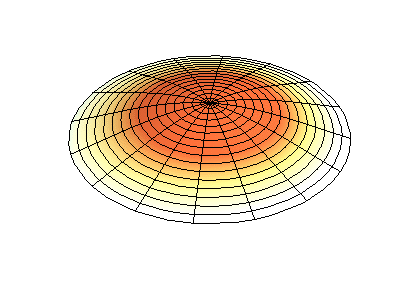

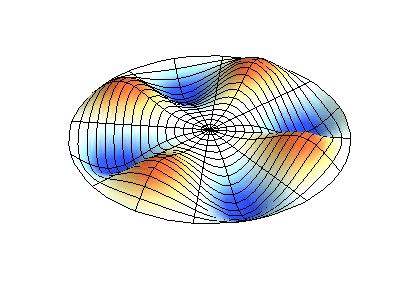
Using some fancy math we can calculate the frequency of the modes and we get the following mode and frequency relation:
| Mode (m,n) | Relative Frequency |
|---|---|
| (0,1) | 1.00 |
| (1,1) | 1.59 |
| (2,1) | 2.14 |
| (0,2) | 2.30 |
| (3,1) | 2.65 |
| (1,2) | 2.92 |
| (4,1) | 3.16 |
| (2,2) | 3.50 |
| (0,3) | 3.60 |
| (5,1) | 3.65 |
| (3,2) | 4.06 |
| (6,1) | 4.15 |
Compared to a vibrating string the frequencies are not harmonically related to the fundamental instead they are enharmonic with respect to the fundamental frequency. Just like a vibrating string the membrane of a drum vibrates in number of its different modes simultaneously. They all will have different amplitudes and all decay at different rates. This makes the sound from a drum so complex and almost impossible to emulate using different waves from a simple harmonic oscillator. The membrane generates more harmonics and they are clustered in an uneven manner unlike the regular spaced overtones in the simple harmonic oscillator. This makes the drum sound atonal and stops us from perceiving a particular pitch and tone of the sound. Also, no matter how carefully you adjust the membrane it will always have slight variations in the tightness and tension across the surface! In an ideal linear system the frequency of the vibration would stay the same regardless of how hard you hit the drum but drums don't behave this way. When you hit a drum harder they produce a higher pitch. This means the fundamental frequency increases with the large displacement of the drumhead when you strike a drum harder. The fundamental frequency is related to the displacement of the membrane in some way.
When a membrane vibrates in a vacuum it needs to just overcome its internal elastic forces but vibrating in air requires extra work to push and pull air molecules around it. This is similar to how it takes more effort to move hands in water than just in air because water provides more resistance. The mass of air around the membrane acts as a weight for the membrane to move and it does not move in sync with the membrane. The membrane looses energy moving this mass of air. But the membrane air system in a bass drum have resonant frequencies that make up for this loss of energy. These resonant frequencies are higher than the fundamental. The mass of air that each mode of vibration has to move is different across all the modes. So when vibrating higher frequency modes of vibration are moving a small subset of the mass of the air and hence vibrate in a completely different way compared to the fundamental. This uneven interaction of the membrane with its surrounding air shifts the higher frequencies of the drum by some value and they becomes somewhat less harmonic with the fundamental.
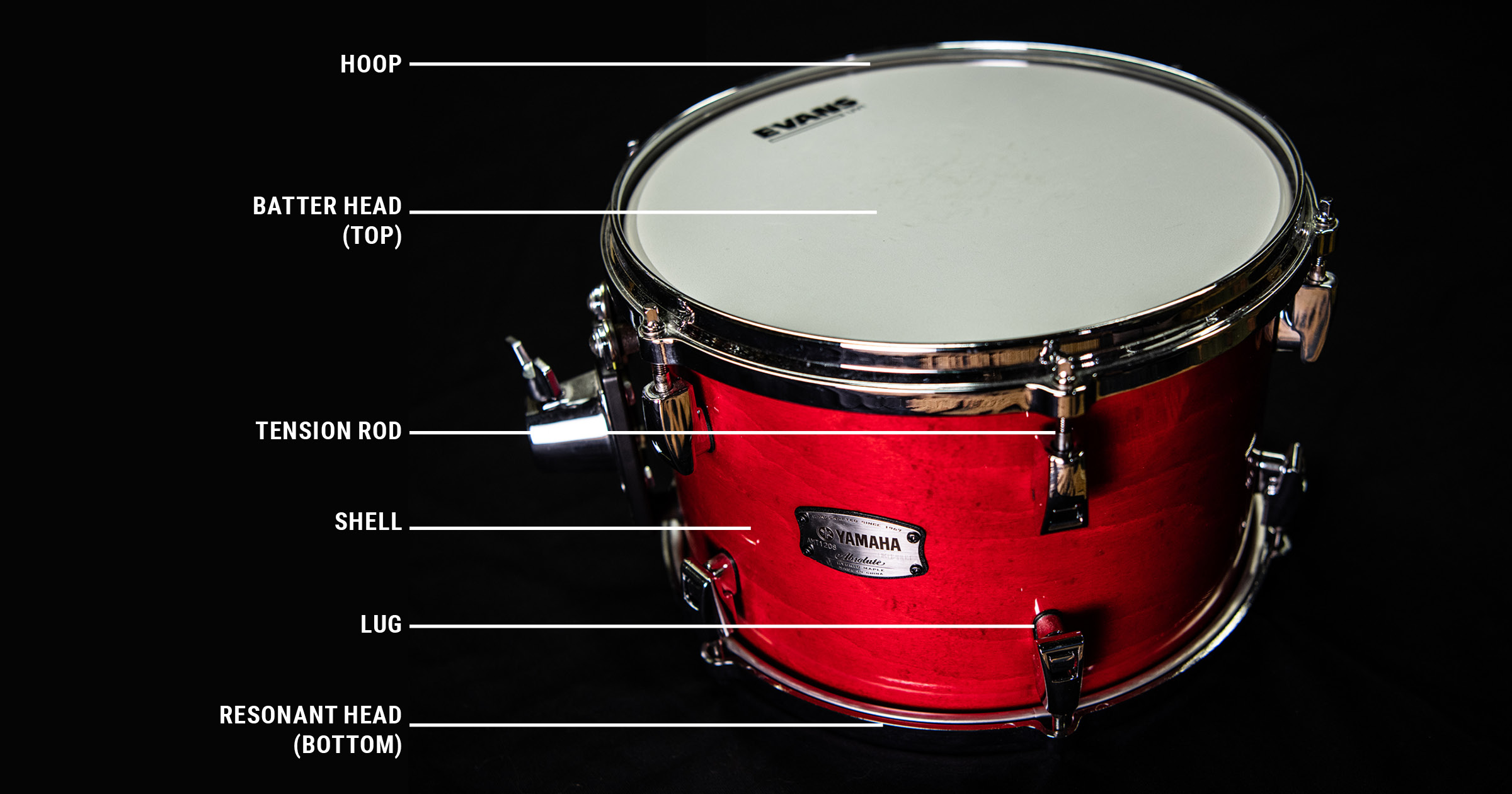
The head that you strike is called the drum head of the batter head and the other is resonating or carry head. With the air trapped inside 2 membranes a drum bass has 3 coupled resonators. In the tables below I have modal frequencies of a standard 22 inch bass drum with the same tension across both the membranes. Due to the trapped air the membrane's vibrations are affected in such a way that we see 2 frequencies each for the first 2 modes. [need more research on why there are 2 frequencies for the first two modes] If we remove the extra modes we see that they are somewhat harmonic but not completely. The frequencies at the upper partials are not integer multiples of the fundamental but in fact they are frequency shifted by 7Hz. This shift comes from both the membranes having the same tension. Here we are assuming that both the membranes have the same tension but bass drums are rarely tuned like that. Usually the carry head (resonator head) is tuned at much lower tension. So table 5 shows the frequencies of a dual membrane with the carry head de-tuned with the batter head. Once you detune the heads the frequency shift of 7Hz disappears and what we get is a almost harmonic partials with respect to the fundamental.
| Mode | Frequency (Hz) | Harmonic Ratio |
|---|---|---|
| 0,1 | 50, 118 | 1.00 |
| 1,1 | 86, 93 | 1.86 |
| 2,1 | 136 | 2.72 |
| 3,1 | 182 | 3.64 |
| 4,1 | 225 | 4.50 |
| 5,1 | 273 | 5.46 |
| Frequency (Hz) | Difference (Hz) | Harmonic Ratio |
|---|---|---|
| 50 | 1.00 | |
| 93 | +43 | 1.86 |
| 136 | +43 | 2.72 |
| 182 | +46 | 3.64 |
| 225 | +43 | 4.50 |
| 273 | +48 | 5.46 |
| Frequencies from table 3 minus 7Hz (Hz) | Harmonic Ratio |
|---|---|
| 43 | 1 |
| 86 | 2 |
| 129 | 3 |
| 175 | 4.07 |
| 218 | 5.07 |
| 266 | 6.19 |
| Mode | Frequency (Hz) | Harmonic ratio relative to 46Hz |
|---|---|---|
| 0,1 | 44 | 0.96 |
| 1,1 | 91 | 1.98 |
| 2,1 | 138 | 3.00 |
| 3,1 | 184 | 4.00 |
| 4,1 | 232 | 5.04 |
| 5,1 | 282 | 6.13 |
A modern kick drum is not exactly like a bass drum. A kick drum which evolved from a bass drum is modified specifically for modern music. A kick drum does not have 2 complete membranes instead there is a hole in the carry head which has several purposes like:
- Sound control: The hole can be used to place dampening materials inside the drum to control the overtones and reduce the sustain creating more punchy sound.
- Microphone placement: Mics can be put in the hole to record the sounds better in live performances.
- Tonal character: The hole changes the acoustics of the drum by releasing the air pressure more quickly.
Having a hole in the membrane surprisingly does not affect the
frequencies of the sound much.
The frequencies of a kick drum have a harmonic spectrum at lower
frequencies with a large number of densely packed enharmonic
frequencies at mid and higher frequencies.
However a drum sound has not only these low frequencies almost
harmonic components, it generates partials between 250Hz and 1Khz so
we must also consider this in our synthesis. We can use Frequency
Modulation to generate the partials. Frequency modulation works by
having one oscillator (modulator) affect the frequency of the other
oscillator (carrier). When the modulation happens in the audio range
(above 20Hz) it creates sidebands i.e. additional frequencies above
and below the carrier frequency. [More on frequency modulation in a
different article soon].
Now that we have the frequency content of the sound let's understand
the amplitude levels of the sound. The amplitude at the lower modes
are the highest hence loudest and the amplitude decreases rapidly at
higher modes of vibration producing higher frequency components. So a
triangle wave or a sawtooth wave will be ideal for the synthesis [more
on this in different article]. After this there are 2 more components
that we need to take into account while synthesising the sound: the
frequency shift and the sound of the beater head 'click'.
The carry head of the kick drum has more freedom to vibrate because of
the hole in the drum. But what causes the pitch change? Remember, the
pitch is entirely dependent on the tension of the membrane.
Let's say you have 22 inch membrane drum and you hit it in the center. The energy from the hit will displace the center by 1/16th of an inch which in turn increases the tension of the membrane. This increase in tension is proportional to the square of the displacement. Since the pitch is determined by the tension this increases the pitch of the modes. This means the pitch of every mode will be higher at the start when there is maximum displacement and will drop as the energy dissipates from the membrane. The pitch of the drum can shift by a couple of semitones from start to finish and we need consider this in our synthesis for a more natural drum sound.
The click comes from the beater hitting the drumhead which sends a shockwave across the membrane of the drum which travel outwards from the point of the impact. Due to this several high frequency partials are formed for a very less amount of time since high frequencies dampen quickly due to the material of the membrane. The stiffness and mass of both the beater and the impact point of the drumhead determine which higher frequencies get more excited.
Now that we have know the frequency content and the amplitude levels
of a bass drum we can think about synthesising the basic sound. To
model the sound this is what we will do:
- have a VCO connected to low pass filter to only allow low frequencies which will be connected to a mixer
- to generate the mid range frequencies an FM setup by having a modulator and a carrier connected to a band pass filter going into the mixer
- the output of the mixer being fed into a VCA. this VCA will also be modulated by an AR (attack release) contour generator to shape the volume of the sound over time. the AR contour generator will also be connected to a attenuator which will be connected to the VCO to modify its pitch in the attack phase.
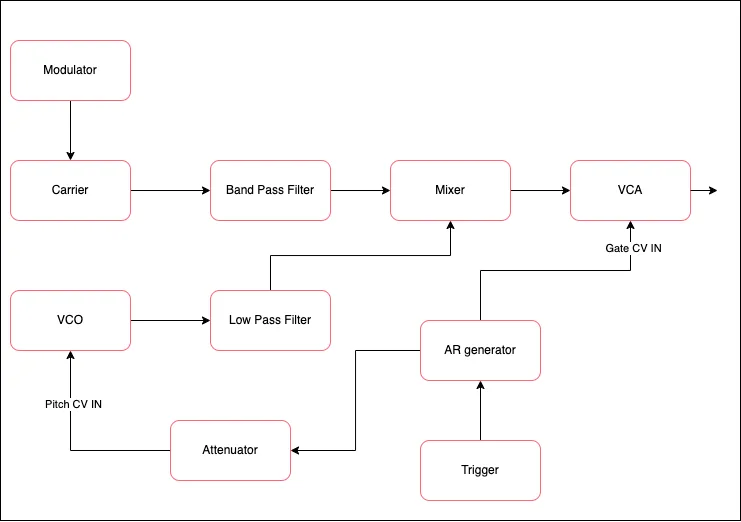
There's still a component missing from this patch and that is the click sound. We can generate the click sound by adding a short burt of white noise at the start or use a contour generator to shape the spectrum of the partials generated by the FM components. To use the latter we can split the band pass filter into a high pass filter and low pass filter. Then we can connect an AR contour generator to the low pass filter to the cutoff frequency of the low pass filter to allow many high frequency components to pass for a very short time.
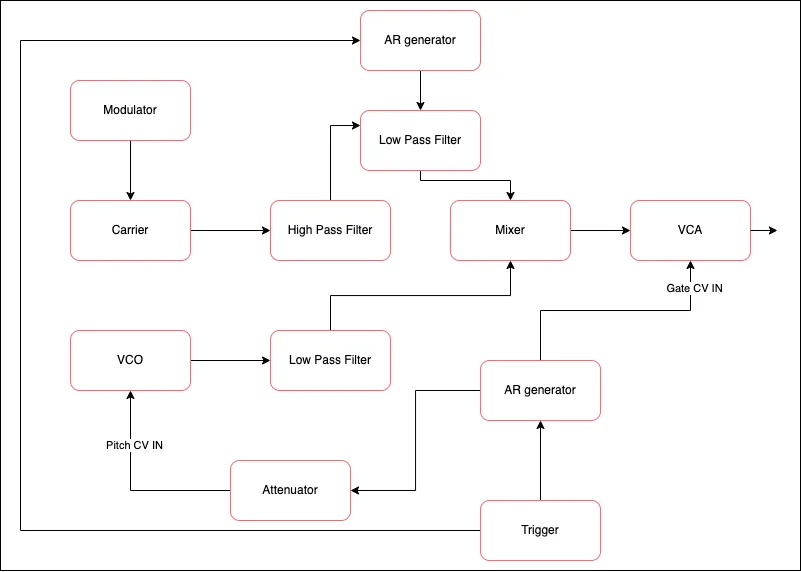
Now that we have the patch ready I will try this out on my Moog Mavis synth post the results here soon.
Update: Patch sound
I am using a Moog Mavis which is a semi modular monophonic analog synthesiser. The patch that I have shown above will not work with my synth since Mavis is a semi modular synth and essentially uses a subtractive synthesis so doing FM synthesis has limitations. But we can still make a patch for a drum kick using the following technique:
Use LFO as the primary oscillator with a triangle wave.
Patch the output of AR contour generator which in this case is the Envelop Generator to attenuator +5. Mavis has an attenuator, which is like a volume knob for a control voltage. The attenuator output then will be patched to the LFO rate.
Patch the output of AR contour generator which in this case is the Envelop Generator to attenuator +5. Mavis has an attenuator, which is like a volume knob for a control voltage. The attenuator output then will be patched to the LFO rate.
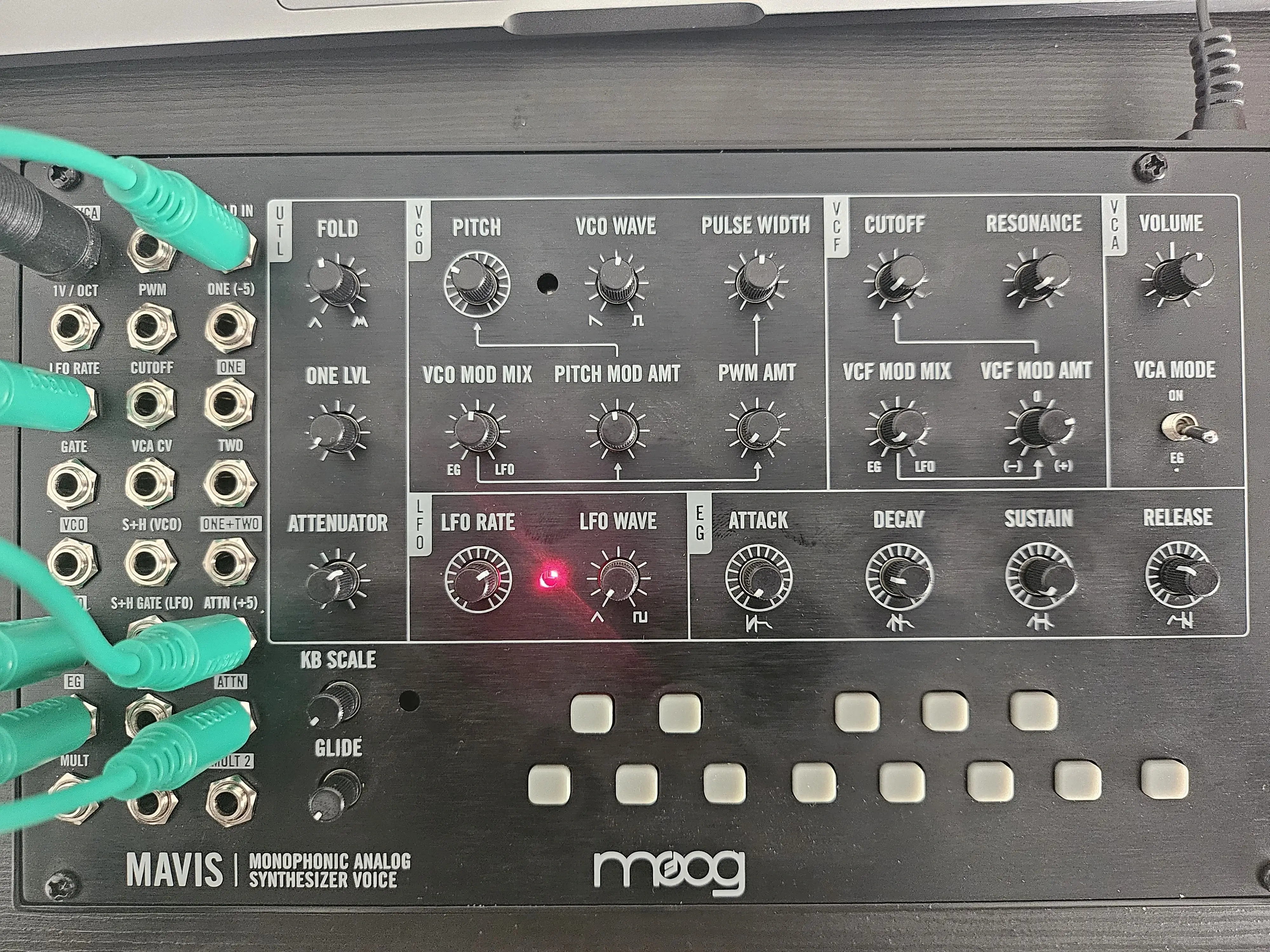
Let's go through the patch and understand what's happening.
When we patch the LFO output to Fold Input we can bypass the default
VCO of the Mavis and use LFO as the main oscillator. We set the LFO
rate and wave by using the knobs and setting a frequency for the drum
sound. For the wave we will use a triangle wave. Then we patch the
Envelop Generator output to Attenuator input and patch the Attenuator
output to LFO rate. With this patch once a trigger is applied we are
using the EG CV to modulate the LFO rate for that instant pitch shift
in the start. Using the Attenuator knob we can control the amount of
the CV being used to shift the pitch in the attack phase of the sound.
For the Envelop Generator we will keep the attack to a minimum with
some decay, very low sustain and a bit of release for the sound. Mavis
uses a Low Pass Filter to remove the harmonics from the sound and we
will keep the knob to its lowest to remove most of the higher
frequencies in the signal.
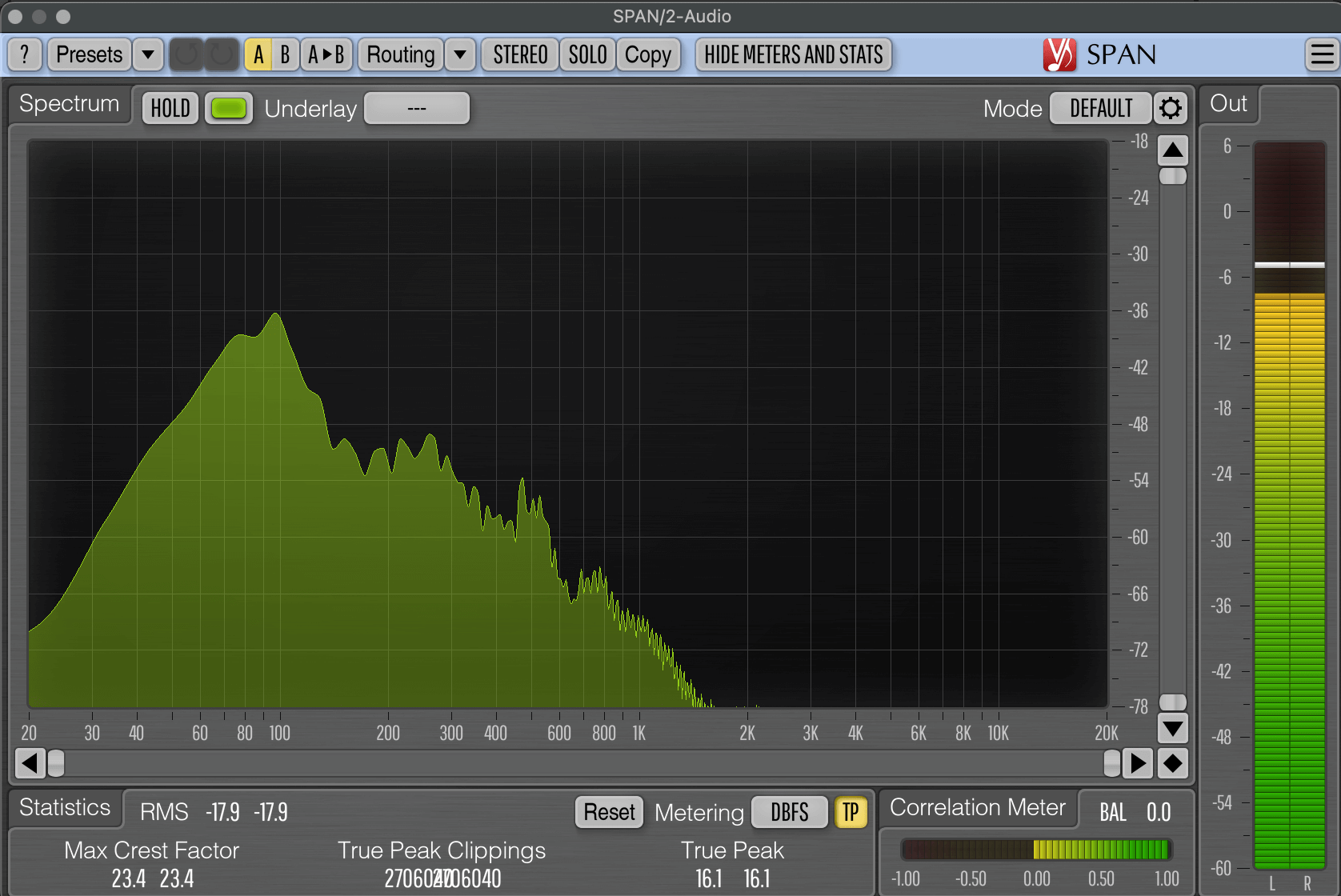
Once we use the keyboard on the Mavis to play the sound this is what we get:
This gives a simple kick drum sound, nothing fancy just a simple sound with some kick drum characteristics. In later articles I'll document how we can make this sound better using different sound design techniques.